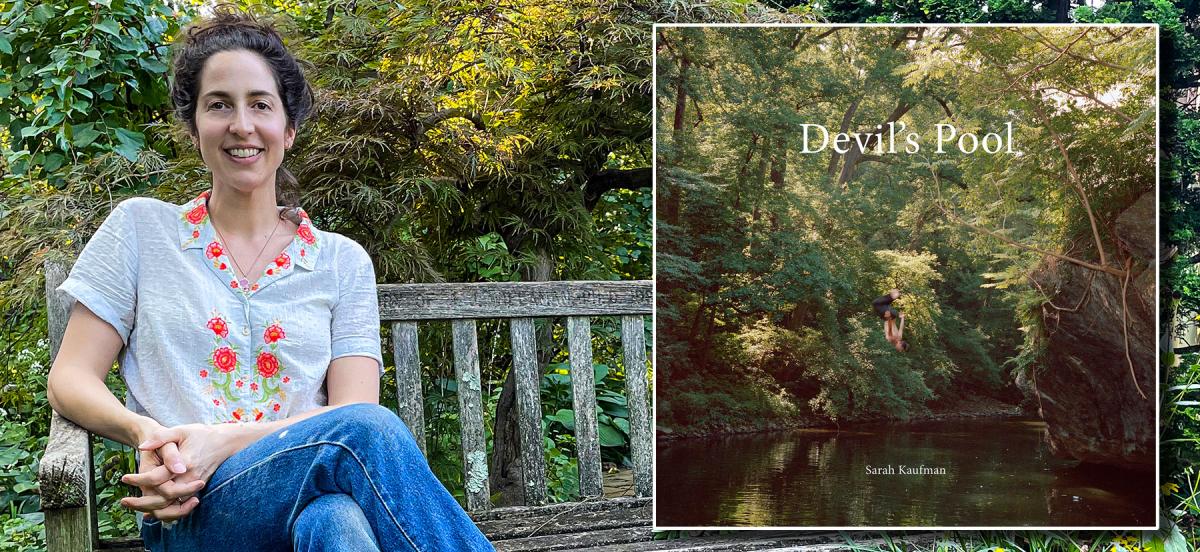Sarah Kaufman '03 Jumps Into "Devil's Pool"

Sarah Kaufman '03, assistant professor of photography and art at Ursinus College, recently published her first book, Devil's Pool, featuring 60 photographs she took in the Wissahickon Valley Park's basin of the same name. Photo by Duncan Holby.
Details
The photographer's latest book captures swimmers and sunbathers at the Wissahickon Valley Park's basin.
As a child growing up near Philadelphia’s Wissahickon Valley Park, photographer Sarah Kaufman ’03 spent hours exploring the nearly-2,000-acre urban oasis. With her Germantown neighborhood skirting the southeast corner of the park, she and her family visited on a regular basis; when she was older, Kaufman explored it on her own. “I did a lot of hiking in the park, and wading and looking for crayfish and catching tadpoles in Wissahickon Creek,” she says. “I remember learning to ride a bike there on a wide gravel trail, and wiping out by a covered bridge.” Now an assistant professor of photography and art at Ursinus College, Kaufman was especially drawn to Devil’s Pool, a 15-foot-deep by 25-foot-wide basin within the park where city dwellers seek relief from summer heat. “Part of growing up was swimming in Devil’s Pool. I remember watching the jumpers (from surrounding rock cliffs), and I have a great memory of sliding down the frozen waterfall there, and walking into the middle of the pool on ice,” she says.
It’s a magical place, says Kaufman, and it’s the subject of her first book, Devil’s Pool (Daylight Books). Packed with 60 color photos chosen from thousands she has taken, the book reflects her fascination with the human body and our connection to nature. “Devil’s Pool has this pull, this beauty of place, and it’s such a source of community,” says Kaufman, who used her 50-year-old twin-lens Rolleiflex camera for the project. She began shooting in 2014 and finished in 2020, with some pauses she says, to have two children, now ages two and five. (Kaufman’s husband, Duncan Holby ’05, is a software developer in the renewable energy industry. And she has another Haverford alum in the family: her dad, Stephen Kaufman ’70.)
Kaufman’s subjects are the everyday folks who jump and swim and hang out at Devil’s Pool. “I’ve always wanted to photograph ‘real’ people, not models,” she says. (That interest was reflected in a 2011 exhibition in Magill Library titled The Nude Redefined, which featured Kaufman’s images of male and female nudes photographed in their homes.)
Kaufman remembers when she first peered through a camera. She was age six or so, and her mom let her look through the viewfinder of a 35mm camera in order to focus on objects. “I have a strong memory of framing photos but not taking them, because there was no film,” she explains. As she grew older, Kaufman used a plastic point-and-shoot camera, a gift from her grandparents, to photograph still lifes in her bedroom. She took a photo class in high school, and at Haverford she decided to be an art major and concentrate on photography. “I didn’t really understand where I could go with photography, I just knew I wanted to study it,” Kaufman says.
In her senior year, her photography professor, William E. Williams, suggested that she try a new format, and she switched from her 35mm camera to the larger, square-format images produced by a Rolleiflex. “I borrowed the camera from him, then as a graduation gift I got my own, and I’ve been using the same camera ever since.” She credits Williams as a mentor and “a steady support and inspiration” to this day.
Post-graduation, Kaufman spent time in Bolivia teaching and photographing, was an art department assistant at Haverford, earned an MFA from Virginia Commonwealth University, and since 2009 has been teaching at Ursinus. In 2011, she co-curated a Cantor Fitzgerald Gallery show titled Through the Plain Camera: Small and Shapely Pleasures in Contemporary Photography, with Rebecca Robertson BMC ’00, another of Williams’s former students. Kaufman, whose studio is in a converted factory building in the Germantown neighborhood, has work on permanent view at the Pennsylvania Convention Center. With the completion of Devil’s Pool, she says she’s spending more time hiking in the Wissahickon and figuring out her next project.



